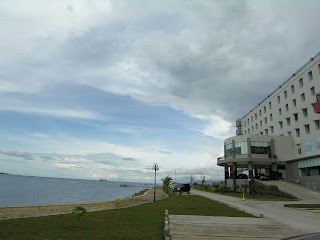Mamuju is the capital of West Sulawesi (the 33rd province of Indonesia). West Sulawesi formed in October 5, 2004 is the division of the province of South Sulawesi . It covers an area of about 16,796.19 km ² divided by 5 regions : Majene, Mamuju, North Mamuju, Polewali Mandar. West sulawesi consists of many tribes : Mandar (49.15%), Toraja (13.95%), Bugis (10.79%), Java (5.38%), Makassar (1.59%) and other tribes (19.15%). Besides cocoa , this area is also producing robusta coffee or Arabica coffee , coconut and clove . In the mining sector, there is the content of gold , coal and petroleum .
Mamuju City is located in between Palu ( Central Sulawesi ) and Makassar ( South Sulawesi ). From the Tampa Padang airport which is about 35 km from City Mamuju, it takes about 30 minutes to take the winding hill as the city is sandwiched between the beach and chocolate-covered hills.
.
Picture 1. Aircraft that can land at the Tampapadang Airport is just the type of Cesna with 10-20 passengers
Picture 2 . Maleo hotel, the best in town now, by the beach.
Pict 3. Sup ubi (at the airport so-called cafe), taste like soto ayam but with fried cassava.
Pict 4. view from the winding hills from airport to mamuju down town.
Pict 5. the famous grilled bandeng. No spice, but fresh grilled.
Pict 6. sunset at the hotel maleo.
Pict 7.sunrise at the hotel facing the harbor.
Sunday, December 26, 2010
Thursday, December 23, 2010
Chewing pinang in West papua
Betel nut palms (pinang) originally grew wild in Southeast Asia, perhaps in the Philippines or Malaysia. They were brought to the Indian subcontinent by humans in prehistoric times.Pinang refers to the seed of Areca catechu, or Betel palm, which, like Cocos nucifera (or the Coconut palm), belongs to Arecaceae (the palm family) and is a kind of evergreen tree whose trunk can grow as tall as twenty meters. The word Pinang originated from Indonesian.
Some countries such as Taiwan also have the habit of chewing pinang.People in some areas of Indonesia like (Java, Sumatra, Nusa Tenggara) used to do this, but for the Papuans, one can easily find people as young as five years old with its telltale red blotches around their mouths, a sign they have been chewing the nut. Chewing areca (known as pinang in Bahasa Indonesia) is an anytime-anywhere activity for Papuans who hold the nut in high regard. Known locally as Tarang Habui, Papuans use areca nuts in traditional ceremonies and present them to guests as a sign of friendship and kinship. For the young areca nut chewing is part of the social language. Papuans chew areca nuts with betel fruit and chalk made from ground white shell. Before chewing, they peel off the betel nut skin using their teeth. They then chew the betel fruit which is dipped in white chalk. Afterwards, they spit out the distinctively bright red juice.
On the streets of Papua areca nut vendors are scattered all over the city. On sidewalks, in front of shops and in markets the nut is available. One packet of pinang, comprising two areca nuts, one betel fruit and chalk goes for Rp 1,000 .
The chewing of Betel Nuts causes mild stimulation and a feeling of well-being. The active compounds in betel nut act as a mild stimulant. The effects include increasedalertness, greater energy, reduced fatigue, talkativeness and excitability. Some users also report euphoric feelings. Powdered betel nut is used as a constituent in some tooth powders. Other medicinal uses include the removal of tapeworms and other intestinal parasites by swallowing a few teaspoons of powdered betel nut, or by taking tablets containing the extracted alkaloids
Subscribe to:
Posts (Atom)









